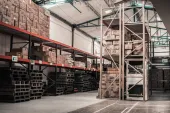
This is the most resilient asset class in the Australian property market
Global capital investment volume to this asset class slipped by only 7% in 2020.
The performance of the Industrial & Logistics asset class demonstrated the greatest resilience of the mainstream commercial property sectors in the year hit by the economic downturn from the COVID-19 pandemic. According to JLL, institutional investment appetite continues to favour this sector due to high quality covenants in institutional grade assets and confidence in the ability to collect income. Industrial & Logistics rent collection rates have remained high across most mature economies.
Global capital investment volume to the industrial asset class decreased by 7% in 2020, compared to 2019, totalling AUD 147 billion (for transactions AUD 5 million and over). This is relatively small when compared to the significant falls in global investment sale volumes recorded for the retail (-35%) and office (-36%) asset classes.
Although global investment volumes fell slightly in 2020, Australia’s Industrial & Logistics investment sales over the year remained elevated and retained a high degree of liquidity through 2020 with multiple domestic and offshore capital sources competing for product. Over 2020 we recorded approximately AUD 4.4 billion in industrial investment sales (for transactions AUD 10 million and over).
Here’s more from JLL:
The Australian Industrial & Logistics property market remains one of the most sought-after sectors, by domestic, regional and global capital sources, as it is underpinned by stable long- term factors. Multiple capital sources continued to compete for assets in 2020 – despite the limited ability to travel throughout the year from lockdown measures prompted by the COVID-19 pandemic, as well as the sharp fall in global and domestic GDP and inflation.
Key themes:
Transaction volumes remained elevated, consistent to the previous year: The Australian Industrial & Logistics sector recorded AUD 4.4 billion of transactions in 2020. Volumes were supported by several recordbreaking portfolio transactions.
Global investors are aware of the relatively larger role that cross-currency impacts play as a factor of returns: A greater number of lenders are seeking to capitalise on cross-currency advantages by way of lending or investing in a region. Australian lending opportunities may present a relative credit-spread-for-risk opportunity for EUR, GBP, JPY and KRW denominated investors, amongst others.
Limited scope for offshore buyers to physically inspect assets on the market: Offshore capital sources remained active participants in the Australian Industrial & Logistics sector, although represented a declined share of total sales volumes. Several offshore investors, mainly from Singapore, Germany and Japan, participated in capital raising by domestic fund managers.
Occupier demand for industrial stock reached an all-time high of 2.9 million sqm in 2020: As eCommerce increasingly contributes to greater space requirements, the Retail Trade sector was - for the first time - the major contributor to floorspace demand in 2020 (contributing 34%).
The Asia Pacific market is growing and, in turn, attracting capital to the region with Australia being a beneficiary: The Australian market offers a liquid, stable and strong return performance trend, low interest rates, a solid economic foundation, and robust growth mainly supported by a proactive COVID-19 containment response, expansionary fiscal policy, infrastructure expenditure, free trade agreements and population growth.
Australia’s industrial investable universe is growing: Approximately AUD 96 billion in value, and estimated to reach AUD 120 billion in value by 2025.
Capital allocation to Australia’s Industrial & Logistics sector is expected to continue to grow: Australia’s Industrial & Logistics sector has consistently delivered comparatively higher average returns than those generated overseas, and has shown low volatility of returns through the current cycle relative to other commercial property sectors.
Critical goods, including food and pharmaceuticals, are significant and stable long-term drivers of the Industrial & Logistics sector: Post pandemic there will be a greater focus on solidifying Australia’s end-to-end supply chain for critical products – from R&D, manufacturing to storage and distribution. This initiative is already underway by the Federal Government.



















 Advertise
Advertise




